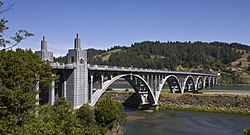Isaac Lee Patterson Bridge: Difference between revisions
m →References: copyedit, refine cat, and AWB general fixes using AWB |
No edit summary |
||
| Line 28: | Line 28: | ||
The '''Isaac Lee Patterson Bridge''', also known as the '''Rogue River Bridge''' and the '''Isaac Lee Patterson Memorial Bridge''', is a concrete arch bridge that spans the [[Rogue River (Oregon)|Rogue River]] in [[Curry County, Oregon]]. The bridge carries [[U.S. Route 101 (Oregon)|U.S. Route 101]] across the river, near the point where the river empties into the [[Pacific Ocean]], and connects the towns of [[Gold Beach, Oregon|Gold Beach]] and [[Wedderburn, Oregon|Wedderburn]]. |
The '''Isaac Lee Patterson Bridge''', also known as the '''Rogue River Bridge''' and the '''Isaac Lee Patterson Memorial Bridge''', is a concrete arch bridge that spans the [[Rogue River (Oregon)|Rogue River]] in [[Curry County, Oregon]]. The bridge carries [[U.S. Route 101 (Oregon)|U.S. Route 101]] across the river, near the point where the river empties into the [[Pacific Ocean]], and connects the towns of [[Gold Beach, Oregon|Gold Beach]] and [[Wedderburn, Oregon|Wedderburn]]. |
||
The bridge is 578.5 m (1,898 ft) long and consists of seven 70 m (230 ft) spans.<ref>{{cite web | title = Oregon Coastal Highway Bridges | publisher = Oregon Department of Transportation | url = http://egov.oregon.gov/ODOT/HWY/GEOENVIRONMENTAL/historic_bridges_coastal.shtml#Rogue_River_Bridge | accessdate = 2008-06-27}}</ref> It was dedicated on May 28, 1932 and named after [[I. L. Patterson|Isaac Lee Patterson]], the governor of Oregon from |
The bridge is 578.5 m (1,898 ft) long and consists of seven 70 m (230 ft) spans.<ref>{{cite web | title = Oregon Coastal Highway Bridges | publisher = Oregon Department of Transportation | url = http://egov.oregon.gov/ODOT/HWY/GEOENVIRONMENTAL/historic_bridges_coastal.shtml#Rogue_River_Bridge | accessdate = 2008-06-27}}</ref> It was dedicated on May 28, 1932 and named after [[I. L. Patterson|Isaac Lee Patterson]], the governor of Oregon from 1927 to 1929. |
||
A bridge with strong Art Deco influences, the Isaac Lee Patterson Bridge is a prominent example of the designs of the Oregon bridge designer and highway engineer [[Conde McCullough]]. It was designated a [[National Historic Civil Engineering Landmark]] by the [[American Society of Civil Engineers]] in 1982. |
A bridge with strong Art Deco influences, the Isaac Lee Patterson Bridge is a prominent example of the designs of the Oregon bridge designer and highway engineer [[Conde McCullough]]. It was designated a [[National Historic Civil Engineering Landmark]] by the [[American Society of Civil Engineers]] in 1982. |
||
Revision as of 02:54, 23 November 2011
Isaac Lee Patterson Bridge | |
|---|---|
 | |
| Coordinates | 42°25′38″N 124°24′48″W / 42.4272°N 124.4133°W |
| Carries | 2 lanes of U.S. Route 101 |
| Crosses | Rogue River |
| Locale | Gold Beach, Oregon to Wedderburn, Oregon |
| Maintained by | State of Oregon |
| ID number | 01172 009 32764 |
| Characteristics | |
| Design | Concrete arch-deck |
| Total length | 578.5 m (1898 ft) |
| Width | 8.2 m (59.1 ft) |
| Longest span | 70 m (230 ft), 7 spans |
| History | |
| Opened | May 28, 1932 |
| Statistics | |
| Daily traffic | 6200 |
| Location | |
 | |
The Isaac Lee Patterson Bridge, also known as the Rogue River Bridge and the Isaac Lee Patterson Memorial Bridge, is a concrete arch bridge that spans the Rogue River in Curry County, Oregon. The bridge carries U.S. Route 101 across the river, near the point where the river empties into the Pacific Ocean, and connects the towns of Gold Beach and Wedderburn.
The bridge is 578.5 m (1,898 ft) long and consists of seven 70 m (230 ft) spans.[1] It was dedicated on May 28, 1932 and named after Isaac Lee Patterson, the governor of Oregon from 1927 to 1929.
A bridge with strong Art Deco influences, the Isaac Lee Patterson Bridge is a prominent example of the designs of the Oregon bridge designer and highway engineer Conde McCullough. It was designated a National Historic Civil Engineering Landmark by the American Society of Civil Engineers in 1982.
McCullough employed a new method of concrete arch construction named the Freyssinet method, named after the French bridge engineer Eugene Freyssinet.[2] This method uses precompressed arches which pemitted the use of smaller arch ribs, thereby reducing the weight and cost of the bridge. McCullough's design was the first usage of this technique in the United States.
References
- ^ "Oregon Coastal Highway Bridges". Oregon Department of Transportation. Retrieved 2008-06-27.
- ^ Hadlow, Robert W. (2001). Elegant Arches, Soaring Spans: C.B. McCullough, Oregon's Master Bridge Builder. Oregon State University Press. pp. 69–79. ISBN 0-87071-534-8.
- Bridges on the National Register of Historic Places in Oregon
- Bridges completed in 1932
- Deck arch bridges
- U.S. Route 101
- Historic Civil Engineering Landmarks
- Concrete bridges
- Art Deco architecture in Oregon
- Buildings and structures in Curry County, Oregon
- Transportation in Curry County, Oregon
- Road bridges in Oregon
